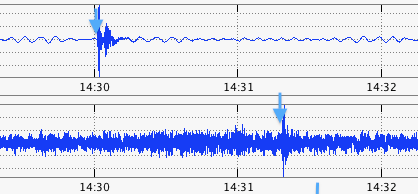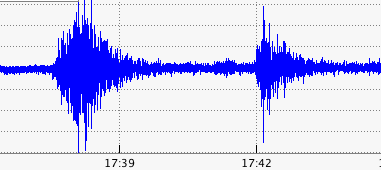Exotic Events (not erotic events)
The main purpose of the Pacific Northwest Seismic Network (PNSN) is to record and study earthquakes to better understand them for the purposes of hazard mitigation. But, there are many things that can shake the ground that are not earthquakes. We call these exotic (erotic in the title was just to get your interest up) events. They are exotic because they are different from the bread and butter earthquakes in which we are mostly interested. Some have waveforms similar to earthquakes while others look totally different. Here we describe general characteristcs of some of these and introduce a new web page listing some of these Exotic Events studied in the past.
Anything that shakes the ground, even by the minutest amount can be recorded by our very sensitive instruments. A person walking within 20 meters of a seismic station will show up as small blips on the seismograms. A car driving within a few hundred meters will show up as a rumbling lasting for seconds or tens of seconds. A train passing within a couple of kilometers of a station may show as a strong rumble lasting for minutes. These sorts of wiggles we call "cultural noise"; "cultural" because they are generated by human activity and "noise" because they are not what we are interested in and often can cover up or hide the real signals (from earthquakes) in which we are interested. Non cultural sources of "noise" include the shaking generated by water moving in nearby streams or rivers or the pounding of surf on the coast. A ubiquitous source of noise is the shaking of the ground due to wind, which can be particularly strong when there are bushes or trees near a seismic station. The wind-like noise of tremor associated with slow slip can go on for many minutes during ETS events. Of course animals such as deer walking near a seismic station will generate blips not unlike a human walking nearby. All of these sources of noise, while not earthquakes, are usually not considered to be "exotic events". They are too common and are of little or no interest.
There are lots of different sorts of seismic signals generated by volcanoes when they are erupting or even just becoming restless. Low-frequency volcanic earthquakes, Long-Period earthquakes and volcanic tremor are the names we give some of these signals. Such events, while certainly "exotic" in the day-to-day world of the PNSN are not reported here but show up in descriptions of volcanoes, particularly Mount St. Helens in separate web pages.
Below is a list of some of the types of exotic events we have recorded with an example from a single station's seismogram. In most cases an analyst will need to see the seismograms from several stations to reliably identify exotic events. Experience, thoughtful reasoning and, best of all, direct confirmation from an eye witness observer may be needed to nail down the source details.
- We start with a typical seismogram from a real earthquake (NOT exotic) for contrast. (Note: In most of these figures the small tics along the top are 1-second intervals.) A real earthquake usually has a sharp beginning (P-wave) that may quickly die down and then a larger arrival (S-wave) that may transition into a longer set of waves (surface-waves or, more generally, coda-waves):

- Often, looking very like a real earthquake, a quarry blast or mining type of explosion will have strong P-waves and weaker S-waves and because they are at or near the ground surface may exite relatively strong surface-waves. If the quarry blast was at the surface and produced an audible "bang" in the air we may record that on a nearby seismograph as a short high-frequency phase many seconds later (near the end of the record in the example below). However, there are many cases where, without direct confirmation from the blasting operation a seismic analyst cannot really be sure and thus may classify such events as "probable explosion". These are not really all that exotic because they are fairly common. Sometime we record more explosions per day than we do real earthquakes.

- Speaking of explosions; what about when an explosion takes place above ground? In this case we may only see the air-wave because not enough energy shakes the ground to generate recordable seismic signals. Two recent accidental explosions from gas and propane leaks were reported in a recent blog. A strange set of signals have been seen on seismic stations in eastern Washington now and then. When we go to extra efforts to locate them, they seem to be coming from the Yakima Firing Range. Because this is a closed military area we are not sure what they are doing but assume it most be artillery practice or some similar thing going "bang" in the air.

- Another type of "bang" in the air is the explosion of a bolide or meteor as it enters the atmosphere. In the few cases where we have been able to reliably identify such things there were news reports of people seeing a flash and maybe hearing a distant "boom". Here are records from two stations for the same event. The major tics in this plot are minutes apart rather than seconds.

- Back to things on the ground. There are all sorts of geological avalanches or slides that shake the earth. The signals from these can be quite complicated. Because the source is usually stretched out in time the signals can likewise last a long time. Here is an example from a rock/ice-fall high on the west side of Mount Adams recorded at a seismic station near Mount Rainier. Apparently a very large section of rock and ice fell steeply for several thousand feet and then slid for a longer period of time on a shallower slope below.

- The signal from a landslide can be quite strong and long even though the total vertical distance traveled may be no more than a few hundred feet. Here is an example from the Oso landslide showing that it occurred in two separate chunks separated in time by over three minutes.

- Snow avalanches usually don't shake the ground very much. Even though they can be devastating to anything caught in them their mass is usually not enough to cause much ground shaking. However if the avalanche is big enough and very dense (wet snow) they too can generate diagnostic seismic signals. Here is an example of a fairly large wet snow avalanche off the east side of Mount St. Helens. Note that this signal lasts for several minutes indicating that the avalanche must have been traveling fairly slowly (wet flow) or its source kept growing over quite a long time.

There are lots of other exotic signals that we record. For many we never really figure out the source. But it is fun detective work to try and do so when something shows up that we don't understand. Check out our Exotic Event page for details of ones we have studied.